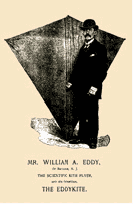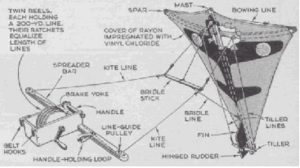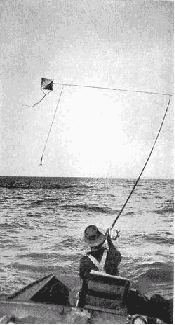Diamond, Eddy or Malay Kite Construction: Difference between revisions
From DT Online
mNo edit summary |
mNo edit summary |
||
| (9 intermediate revisions by the same user not shown) | |||
| Line 5: | Line 5: | ||
=====Description===== | =====Description===== | ||
[ | [http://en.wikipedia.org/wiki/Malay_kite '''Diamond, Eddy or Malay Kites'''] are suitable for light to moderate breezes | ||
Some general proportions and a basic method of construction is shown opposite. | Some general proportions and a basic method of construction is shown opposite. The ''''Cross Spar'''' of the kite can be bowed by stretching a bowstring across it. Alternatively, the '''‘Cross Spar’''' can be made in to halves, joined at an angle to form a '''[[Kite Design Basics|Dihedral]]''' or a '''[[Kite Design Basics|Keel]]''' may be added. The effect is to make the kite more stable in that it may float on the air much as a boat hull on water. | ||
If the kite proportions are changed to create a square diamond and the '''Cross Spar''' given a '''[[Kite Design Basics|Dihedral]]''', the kite becomes '''Tetrahedral''' and several can be joined together to make a '''Multi-cell''' kite ''(you will need to press '''Return''' after each change of value)''. | |||
---- | ---- | ||
[[File:AngleofAttack.png| | [[File:AngleofAttack.png|150px|right]] | ||
<span style="color: green">'''Note:''' | <span style="color: green">'''Note:''' | ||
Once you have finalised your '''Kite''' proportions, the '''[[Kite Design Basics|Angle of Attack]]''' can be set by adjustment of the '''Bridle'''. The normal method is to loop the '''Bridle''' over one finger and suspend the '''Kite''' upside down. The position of the finger is adjusted until the tail of the '''Kite''' hangs at an angle of 20<small><sup>0</sup></small> to 30<small><sup>0</sup></small> to the floor. | Once you have finalised your '''Kite''' proportions, the '''[[Kite Design Basics|Angle of Attack]]''' can be set by adjustment of the '''Bridle'''. The normal method is to loop the '''Bridle''' over one finger and suspend the '''Kite''' upside down. The position of the finger is adjusted until the tail of the '''Kite''' hangs at an angle of 20<small><sup>0</sup></small> to 30<small><sup>0</sup></small> to the floor. | ||
| Line 25: | Line 29: | ||
More sophisticated '''Kites''', and most commercially available ''' | More sophisticated '''Kites''', and most commercially available '''Kites''', use '''[[Basic Kite Construction|Ripstop Nylon]]''' or similar, together with '''[[Basic Kite Construction|Fibreglass Rods and Tubes]]'''. Instead of fixing with tape, extra allowances are added to the '''Kite''' pattern where needed, to enable the '''Spars''' to be slotted into sewn hems. | ||
| Line 34: | Line 38: | ||
---- | ---- | ||
<span style="color: green">'''Note:'''</span> | <span style="color: green">'''Note:'''</span> | ||
* <span style="color: green">The main variable in the table below is the total length of the '''Kite Spine''' ''(set initally to 1200mm)</span> | * <span style="color: green">The main variable in the table below is the total length of the '''Kite Spine''' ''(set initally to 1200mm)</span>. | ||
* <span style="color: green">Almost all other dimensions are derived as a '''Percentage of the Spine Length''' ''(e.g the total '''Width''' is set | * <span style="color: green">Almost all other dimensions are derived as a '''Percentage of the Spine Length''' ''(e.g the total '''Width''', <<span style="color: red">MaxWidthPercent</span>>, is set initially as equal to the <<span style="color: red">SpineLength</span>> - or 100%)''</span>. | ||
* <span style="color: green">All '''Percentages''' initially are based on the proportions given at the start of this article but all can be changed by clicking in the table and typing in a new '''Percentage''' ''(e.g. to make a square '''Diamond''' increase the | * <span style="color: green">Note that either numbers or <<span style="color: red">variable names</span>> may be typed in to alter kite proportions</span>. | ||
* <span style="color: green">You will need to press '''Return''' after each change of value</span>. | |||
* <span style="color: green">All '''Percentages''' initially are based on the proportions given at the start of this article but all can be changed by clicking in the table and typing in a new '''Percentage''' ''(e.g. to make a square '''Diamond''' increase the <<span style="color: red">CrossSparTopPercent</span>> to 50%)''</span>. | |||
* <span style="color: green">Refreshing or reloading the page will reset all variables to their default values.</span>. | |||
See '''[[Packaging Designer User Guide]]''' for further information. | |||
---- | ---- | ||
| Line 44: | Line 53: | ||
=====Diamond Kite Examples===== | =====Diamond Kite Examples===== | ||
* In May 1891, [ | * In May 1891, [http://en.wikipedia.org/wiki/William_Abner_Eddy '''William Eddy'''] attached Malayan kites together to gain the height needed for weather measurements. | ||
* In 1942, US Navy Commander [http://robroy.dyndns.info/targetkites/ '''Paul Garber'''] develops a controllable diamond kite to provide targets for gun practice. | * In 1942, US Navy Commander [http://robroy.dyndns.info/targetkites/ '''Paul Garber'''] develops a controllable diamond kite to provide targets for gun practice. | ||
| Line 50: | Line 59: | ||
{| | {| | ||
|- | |- | ||
| [[File:DiamondKiteImages-1.png|thumb| William Abner Eddy, with his kite|link= | | [[File:DiamondKiteImages-1.png|thumb| William Abner Eddy, with his kite|link=http://commons.wikimedia.org/wiki/File:PicEddyKite.jpg]] | ||
| [[File:DiamondKiteImages-2.png|thumb|Target Kite|link=http:// | | [[File:DiamondKiteImages-2.png|thumb|Target Kite|link=http://aerohistory.org/target/va-intro.htm]] | ||
| [[File:DiamondKiteImages-3.png|thumb| | | [[File:DiamondKiteImages-3.png|thumb|Kite Fishing|link=http://en.wikipedia.org/wiki/Kite_fishing]] | ||
|} | |} | ||
| Line 61: | Line 70: | ||
[[Category:Topics, Projects and Tasks]] | [[Category:Topics, Projects and Tasks]] | ||
[[Category:The Tudors]] | |||
[[Category:The Victorians]] | |||
[[Category:Structures Tasks]] | [[Category:Structures Tasks]] | ||
[[Category:Tasks]] | |||
[[Category:Kites]] | [[Category:Kites]] | ||
Latest revision as of 12:23, 6 April 2018
Description
Diamond, Eddy or Malay Kites are suitable for light to moderate breezes
Some general proportions and a basic method of construction is shown opposite. The 'Cross Spar' of the kite can be bowed by stretching a bowstring across it. Alternatively, the ‘Cross Spar’ can be made in to halves, joined at an angle to form a Dihedral or a Keel may be added. The effect is to make the kite more stable in that it may float on the air much as a boat hull on water.
If the kite proportions are changed to create a square diamond and the Cross Spar given a Dihedral, the kite becomes Tetrahedral and several can be joined together to make a Multi-cell kite (you will need to press Return after each change of value).
Note: Once you have finalised your Kite proportions, the Angle of Attack can be set by adjustment of the Bridle. The normal method is to loop the Bridle over one finger and suspend the Kite upside down. The position of the finger is adjusted until the tail of the Kite hangs at an angle of 200 to 300 to the floor.
See the DT Online article on Kite Design Basics for more information about the forces acting on a kite and how to use tails or drogues to balance them.
Materials and Construction
Kites can be made quite successfully using thin Polyethylene sheeting (e.g. as used to make bin liners) and Adhesive Tapes, split Bamboo flower sticks. Kraft Paper can also be used and even Tissue Paper, especially for smaller Kites and using BBQ Skewers for Spars.
More sophisticated Kites, and most commercially available Kites, use Ripstop Nylon or similar, together with Fibreglass Rods and Tubes. Instead of fixing with tape, extra allowances are added to the Kite pattern where needed, to enable the Spars to be slotted into sewn hems.
See the DT Online article on Basic Kite Construction for more detail.
Designer
- Click on the pencil-shaped Edit icon below to show or hide variables and click inside table to alter values (scroll to see all).
- Left or Right click on the screen display or use Scroll Wheel to alter view and Left click on Zoom icon to restore (note: Zoom will be focussed around the cursor position)
- Left click on Download icon and Open with your preferred browser then print screen image from there (useful for trying ideas for text and graphics etc. but unlikely to be actual size), or Save File to create a full-size Scalable Vector Graphics (svg) file which can be loaded into LibreOffice Draw and printed, or graphics software such as Inkscape for eventual output at actual size to a Plotter/Cutter for example. See Packaging Designer User Guide for more detail.
Note:
- The main variable in the table below is the total length of the Kite Spine (set initally to 1200mm).
- Almost all other dimensions are derived as a Percentage of the Spine Length (e.g the total Width, <MaxWidthPercent>, is set initially as equal to the <SpineLength> - or 100%).
- Note that either numbers or <variable names> may be typed in to alter kite proportions.
- You will need to press Return after each change of value.
- All Percentages initially are based on the proportions given at the start of this article but all can be changed by clicking in the table and typing in a new Percentage (e.g. to make a square Diamond increase the <CrossSparTopPercent> to 50%).
- Refreshing or reloading the page will reset all variables to their default values..
See Packaging Designer User Guide for further information.
Diamond Kite Examples
- In May 1891, William Eddy attached Malayan kites together to gain the height needed for weather measurements.
- In 1942, US Navy Commander Paul Garber develops a controllable diamond kite to provide targets for gun practice.

















